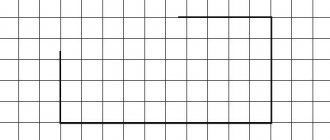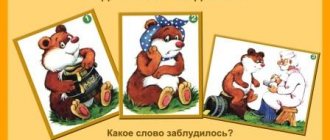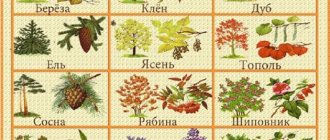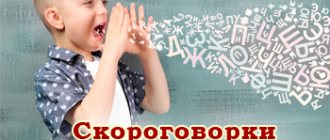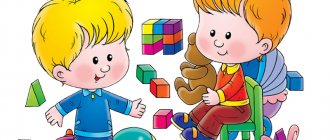Compiling stories based on plot pictures in the preparatory group
Alexandra Bocharova
Compiling stories based on plot pictures in the preparatory group
In classes in a preparatory group for school, a teacher’s model should be offered only if the children have poor ability to coherently present the content of a picture . In such classes, it is better to give a plan, suggest a possible plot and sequence of the story . In groups of senior preschool age, all types of stories based on a picture : a descriptive story based on subject and plot paintings , a narrative story , a descriptive story based on a landscape painting and still life .
You can widely use a story based on a series of pictures (for example, on the topic “Our site in winter and summer”
, where what is required is no longer a simple listing of ongoing events, but a consistent
story with a beginning , culmination and denouement. The conversation on issues that precedes the story concerns the main points, the key points of the depicted plot .
improve the ability to tell stories based on a series of pictures : compiling a collective story - the teacher begins the story , the children finish; One child starts, another continues.
In the preparatory group, children are first introduced to composing narrative stories . So, they come up with a beginning or an end to the plot depicted in the pictures : “That’s how it went for a ride!”
,
“Where did you go?”
,
“Gifts for Mom for March 8th”
,
“The Ball Flew Away”
,
“Cat with Kittens”
, etc. A clearly formulated task encourages you to creatively complete it.
It is very important to teach children not only to see what is depicted in the picture , but also to imagine previous and subsequent events. For example, based on these pictures, the teacher can ask the following questions: What did the guys say to the boy? ( "That's how I rode!"
);
How did the children prepare gifts for their mother? ( "March 8"
);
who put the basket here and what happened? ( "Cat with Kittens"
).
Several questions may be asked, as if outlining the plot line of the narrative story : where did these children come from? What happened to them next? How did these children continue to be friends? ( "Waiting for guests"
)
The same picture can be used several times during the year, but different tasks should be set, gradually making them more difficult. When children master free storytelling , you can offer them two or more paintings (already seen and even new ones)
and set a task - to come up with
a story based on any picture . This will give them the opportunity to choose the content that is most interesting to them, and for those who find it difficult, an already familiar plot , which is easy to use to compose a story .
Such activities develop independence and activity, and foster a sense of self-confidence. In the senior and preparatory groups, work continues to develop the ability to characterize the most significant things in a picture . The emphasis on what is essential comes out most clearly in the selection of the name of the painting , so children are given tasks like “What did the artist call this painting ?”
,
“Let’s come up with a name”
,
“What can we call this
picture ?” .
Along with highlighting and characterizing the most essential, one must learn to notice details, convey the background, landscape, , etc. d.
The teacher teaches children to introduce short descriptions of nature stories Of great importance in this case is such a methodological technique - analysis of the teacher’s story . Children are asked questions: “Where did I start my story ?”
,
“How is my
story different from Alyosha’s story ?” , “How did I
talk about the time of year depicted in the picture ?”
Gradually, older preschoolers learn to supplement their stories based on the picture with a description of the depicted landscape, , etc. d. Here, for example, is the beginning of Marina’s story (6 years old)
based on
the painting “That’s how I rode!”
: “This
picture depicts winter .
The day is sunny and cold. And the sky is all colorful. It’s because of the sun that it glows so much.” The introduction of such small descriptions a story based on a painting prepares children for composing stories based on landscape paintings and still lifes . This type of storytelling is used in the pre-school group .
Notes on the development of speech "Composing a story using pictures" (preparatory group) Notes on the development of speech (preparatory group) "Composing a story using pictures" Objectives: learn to compose a story based on.
Summary of educational activities for speech development “Composing stories based on subject and plot pictures” Purpose: to learn to compose stories based on subject and plot pictures using prepositions; answer questions about the content of the text you listened to;
Summary of educational activities on the formation of monologue speech “Telling the story of pictures “Visiting a fairy tale” Synopsis of the educational activity on the formation of monologue speech with preschool children Topic: telling the story of pictures “Visiting a fairy tale.”
Summary of the lesson “Composing stories about Dymkovo, Filimonov, Kargopol toys” in the middle group of HVZ Educational area: “Speech development”; fiction. Pedagogical goal: to teach children to write a descriptive story.
Summary of a lesson on speech development in the preparatory group “Writing descriptive stories about pets” OOD in the mixed-age group “Writing descriptive stories about pets” Objectives: • continue to introduce pets.
GCD for the development of speech of children of the preparatory group for school “Composing stories on the theme “Autumn has come” GCD for the development of speech of children of the preparatory group for school Topic: Composing stories on the theme “Autumn has come” Integration of educational.
Speech development in the older group. Compiling a story based on pictures “We bought a puppy” Speech development in the older group. Topic: “Compiling a plot story based on the pictures “We bought a puppy.” Goal: learn to write a descriptive story.
Compiling a story based on reference pictures on the topic “Winter” Summary of a speech therapy lesson on the formation of coherent speech in a preparatory group for children with ODD. Topic: Compiling a story using reference points.
LiveInternetLiveInternet
Quote from Tatyana57
Read in full In your quotation book or community!
WE TEACH CHILDREN 5-6 YEARS OLD TO RELL, COMPLETE STORIES FROM PICTURES.
Retelling the story “A Rich Harvest” using plot pictures.
1.Reading a story. Swans. Grandfather stopped digging, tilted his head to the side and listened to something. Tanya asked in a whisper: “What’s there?” And grandfather answered: “Do you hear the swans trumpeting?” Tanya looked at her grandfather, then at the sky, then again at her grandfather, smiled and asked: “So, do swans have a trumpet?” Grandfather laughed and answered: “What kind of pipe is there?” They just scream so long, so they say they are blowing trumpets. Well, do you hear? Tanya listened. Indeed, somewhere high up, drawn-out, distant voices were heard, and then she saw the swans and shouted: “I see, I see!” They fly like a rope. Maybe they will sit somewhere? “No, they won’t sit down,” said grandfather thoughtfully. - They fly away to warmer climes. And the swans flew further and further. 2. Conversation. - Who is this story about? -What was grandfather listening to? - Why did Tanya smile at her grandfather’s words? - What does “swans trumpet” mean? - Who did Tanya see in the sky? - What did Tanya really want? - What did grandfather answer her? 3.Retelling the story. Compiling the story “How the Sun Found a Shoe” based on a series of plot paintings.
1. Conversation on the picture. — What time of year is shown in the picture? - By what signs did you guess that it was winter? -Where are the children gathered? - Think about who built the slide? - Which of the children just came to the slide? - Pay attention to the boys. What do you think they argued about? - Look at Natasha. What does she tell the boys? - How did this story end? - Give the picture a title. 2. Sample story. Common slide. Winter came. White, fluffy, silver snow fell. Natasha, Ira and Yura decided to build a slide out of snow. But Vova did not help them. He was sick. It turned out to be a good slide! High! Not a hill, but a whole mountain! The guys took a sled and had fun riding down the hill. Three days later Vova came. He also wanted to sled down the hill. But Yura shouted: “Don’t you dare!” This is not your slide! You didn't build it! And Natasha smiled and said: “Ride, Vova!” This is a shared slide. 3.Retelling the story. Compiling the story “Family Dinner” based on a series of plot paintings.
img src=/font
1. Conversation. — How do we communicate with each other if we are nearby? - And if a person is not nearby, then what do we do? — What can be classified as means of communication? — What can be sent by mail? — How was mail delivered before? — How did the telegraph work? — How long does it take now to send a message? - What do people use for this? — How does the postal service deliver letters and greeting cards to us? — Why do people write letters and greeting cards to each other? 2. Compilation of a story. How do we communicate? By talking, we communicate with each other. But sometimes a loved one is far away. Then telephone and mail come to the rescue. Having dialed the desired phone number, we will hear a familiar voice. And if you need to send a letter or a greeting card, you can go to the post office. Previously, mail was delivered on horseback. Then the Morse telegraph machine appeared, and messages began to be transmitted over wires using electric current. Engineer Bell improved the Morse machine and invented the telephone. Nowadays, messages with text and pictures can be transmitted very quickly. To do this, people use a cell phone and a computer. But even now people continue to write letters to each other, send greeting cards and telegrams by mail. Mail is delivered by car, rail or air. 3.Retelling the story. Compiling a story based on the plot painting “In a Living Corner.”
1. Conversation. -Who do you see in the picture? - Name the plants that are in the living corner. — Do children like to work in a living area? Why? -Who is working in the living area today? — What are Katya and Olya doing? — What kind of leaves does ficus have? — Why does Dasha like to take care of fish? What are they? — What should you do if a hamster lives in a living area? What is he like? — What birds live in the living area? —Where is the cage with the parrots? What parrots? — How do the guys do their work? — Why do they like to take care of animals and plants? 2. Compiling a story based on the picture. In a living corner. There are many plants and animals in the living area. Children enjoy watching and caring for them. Every morning when the children come to kindergarten, they go to the living corner. Today Katya, Olya, Dasha, Vanya and Natalya Valerievna are working in the living corner. Katya and Olya are caring for a ficus: Katya wipes its large shiny leaves with a damp cloth, and Olya waters the plant. Dasha likes fish: they are very bright and happily eat the food that she pours into the aquarium. Vanya decided to take care of the hamster: he cleans its cage and then changes the water. Natalya Valerievna feeds motley parrots. Their cage hangs high and the kids can’t reach it. Everyone is very focused and trying to do their job well. 3.Retelling the story. Compiling the story “The Hare and the Carrot” based on a series of plot paintings. 1. Conversation on a series of paintings. — What time of year is shown in the picture? — What can you say about the weather? - How much does a snowman cost? -Who ran past the snowman? -What did he notice? - What did the bunny decide to do? - Why couldn’t he get the carrot? - What did he plan to do next? — Did the ladder help him get to the carrot? Why? — How has the weather changed compared to the first picture? — What can you say about the mood of the bunny in the second picture? - What's going on with the snowman? — How does the sun shine in the third picture? -What does a snowman look like? — What is the bunny’s mood? Why? 2. Compilation of a story. Hare and carrot. Spring has come. But the sun rarely peeked out from behind the clouds. The snowman that the children made in winter stood there and didn’t even think about melting. One day a bunny ran past the snowman. He noticed that the snowman had a tasty carrot instead of a nose. He started jumping up and down, but the snowman was tall and the bunny was small, and he couldn’t get the carrot. The bunny remembered that he had a ladder. He ran into the house and brought a ladder. But even she didn’t help him get the carrots. The bunny became sad and sat down next to the snowman. Then the warm spring sun peeked out from behind the clouds. The snowman slowly began to melt. Soon the carrot ended up in the snow. The joyful bunny ate it with pleasure. 3.Retelling the story. A retelling of the fairy tale “Spikelet” using a series of plot paintings. 1.Reading a fairy tale. 2. Conversation. - Who is this fairy tale about? — What did the little mice do all day? - What can you call the mice, what are they like? And the cockerel? - What did the cockerel find? - What did the little mice propose to do? - Who threshed the spikelet? — What did the little mice propose to do with the grain? Who did it? - What other work did the cockerel do? - What were Krut and Vert doing at that time? — Who was the first to sit down at the table when the pies were ready? — Why did the little mice’s voices become quieter after each question from the cockerel? - Why didn’t the cockerel take pity on the mice when they left the table? 3.Retelling a fairy tale. Compiling the story “Where the bread came from” based on a series of plot paintings.
1. Conversation. — Who do you see on the go-kart? — What toys do you see in the picture? —Which child likes to play with a teddy bear? Who's with the cars? - How is mommy in the mood? What is she unhappy about? - When could this happen? -Where do you think mom went? -Who was left at home alone? What did the children promise their mother? — What was Katya doing? And Vova? —Whose beads are scattered on the floor? - Do you think mom allowed me to take the beads? -Who took them? — Why were the beads torn? — How did the children feel when their mother returned? 2. Compilation of a story. Alone at home. Mom went to the store to do some shopping. And Katya and Vova were left at home alone. They promised mom that everything would be fine. Katya took her favorite bear and began to tell him a story, and Vova played with cars. But suddenly Katya saw her mother’s beads. She really wanted to try them on. She took the beads and began to try them on. But Vova said that mother did not allow Katya to touch them. Katya did not listen to Vova. Then Vova began to remove the beads from Katya’s neck. But Katya didn’t let them take them off. Suddenly the thread broke and the beads scattered on the floor. At this time, mom returned from the store. Vova hid under the blanket out of fear, and Katya stood and looked guiltily at her mother. The children were very ashamed that they had not kept their promise. 3.Retelling the story. Compiling the story “The Border of the Motherland is Locked” based on a series of plot paintings.

